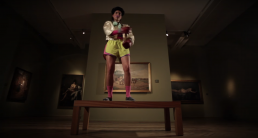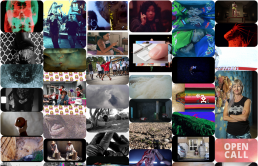“FUSO 2021 – 25 a 29 de Agosto
27 Agosto, 22h00
Palácio Sinel de Cordes – Trienal de Arquitetura de Lisboa
LENGUAS DE FUEGO
Contra-narrativas sexodissidentes à ferida colonial
Agustin Pérez Rubio (ES)
Baseado no texto fundacional de Gloria Anzaldúa (1942-2004) – considerado por muitos como a obra seminal do nascimento dos estudos queer decoloniais – o título deste programa, tal como o trabalho da autora, enfatiza os poderes hegemónicos coloniais e renova a luta contra esses poderes. Mulher, chicana, lésbica e mestiça, poetisa, educadora e artista, Anzaldúa publicou em 1981 o seu já lendário livro Borderlands/La Frontera. A sua escrita, enquanto ferramenta política e decolonial, denunciou os séculos de exploração, segregação e violência aos quais as mulheres subalternizadas foram submetidas, lançando as bases para o que veio a ser conhecido por “feminismo de fronteira”, refletindo sobre as relações de género, o corpo, raça e classe social.
O livro de Anzaldúa abarca e expande as noções de fronteira geográfica e linguística. Dessa forma, a sua língua é também o seu corpo e a sua identidade fronteiriça, que ao mesmo tempo questiona as identidades sexuais e nacionais. Para ela, os sujeitos fronteiriços têm falta de identidade e de lugar, evidenciando a marginalização e opressão a que estes corpos têm sido histórica e socialmente submetidos até aos nossos dias.
Esses territórios/corpos existem como um terceiro espaço entre as entidades estabelecidas. A fronteira de Anzaldúa é uma defesa do essencialismo da mestiçagem, fugindo dos valores do puro e do unívoco.
Os cinco artistas que integram o programa falam a partir de uma diversidade sexo-genérica de fronteira com línguas de fogo, recusando-se a ser novamente silenciados. Questionam e desmontam os modos de pensar e de fazer que o traçado histórico colonial produziu em termos de objetificação das atitudes, corpos e culturas. Mostram com raiva e ironia, mas também com sinceridade, o sofrimento psicológico, físico e imaginário que a hegemonia colonial apagou, estigmatizou e oprimiu com a sua medicalização psico-cientificista, o seu racismo epistémico, a sua fobia sexogénica divergente, o seu conservadorismo monoteísta. Os trabalhos destxs artistxs põem em xeque as teorias que se escondiam por detrás de todas essas ações, juntamente com os valores de transmissão que levaram à criação de muitas das nossas práticas, que vão do psicológico ao corpóreo e do terreno ao simbólico, de forma a alcançar a emancipação e a articulação dessa noção de fronteira.
A cultura europeia-ocidental programou-nos para sermos máquinas ao serviço do patriarcado, perpetuando as lógicas coloniais que impõem o seu pensamento cartesiano, e, consequentemente, continuam a exercer o seu racismo institucional e endémico. É difícil, para os europeus, colocarem-se numa posição humilde de quem escuta e atua como intermediárixs culturais, e não na posição colonial dos detentores do conhecimento.
É urgente parar de nomear os pais cisheteropatriarcais brancos da nossa cultura mental e académica. E não envolver o nosso nome num espaço económico e simbólico por eles criado. Rever xs nossxs poderes e modos de atuar na nossa práxis.
Pôr de lado o machismo aberrante da psicologia freudiana e substituí-lo por outros modos de produção comunitária de conhecimento e de espiritualidades. Perceber que os corpos dissidentes da História e da sua atitude colonizadora estão sedentos de uma conspiração coletiva, travando a santificação da modernidade enquanto processo de transmissão colonial, destinado a promover uma necropolítica, onde o museu é apenas um mausoléu, que continua a enclausurar, física e simbolicamente, a vida das pessoas. Estas obras apelam a um sentimento ético no qual a espera não é uma opção para consertar e sanar todos estes traumas coloniais.
Agustin Pérez Rubio
SCHREBER IS A WOMAN _El Palomar (ES), 2020, 26’
Schreber is a Woman é baseado no caso e nas memórias de Daniel Paul Schreber, um juiz alemão que foi confinado no hospício para doentes mentais de Sonnenstein, na Saxónia, em 1894. Na sua Memoirs of My Nervous Illness, de 1903, Schreber conta que se sentia como mulher, entre outros sentimentos. O livro serviu para a elaboração das teorias sobre paranoia e esquizofrenia de Sigmund Freud. Um fator relevante na história de Schreber tem a ver com o seu pai, o Dr. Moritz Schreber, que escreveu vários livros que propunham modelos estritos e autoritários para a educação física e moral das crianças, livros que eram muito populares na Alemanha e noutros países europeus na viragem do século.
El Palomar revela e reinterpreta a experiência e a escrita de Schreber a partir de uma perspetiva transfeminista, que resiste a conceitos de confinamento e exclusão, de domesticação e de controlo; desconstrói a ligação freudiana com Schreber e a esquizofrenia paranóide a partir de um ponto de vista queer. Focando-se nas imagens e sons que Schreber descreve nas suas memórias, o vídeo propõe uma releitura, na forma de um musical contemporâneo, de um caso passado numa época na qual estavam enraizadas as identidades de género, que se restringiam aos arquétipos binários clássicos. Schreber is a Woman subverte as circunstâncias das linhagens queer, recontextualizando género e prazer na época contemporânea.
Encomendado e financiado por: Berlin Biennale for Contemporary Art
O QUE NÃO TEM ESPAÇO ESTÁ EM TODO O LUGAR _Jota Mombaça (BR), 2020, 10’24’’
O que não tem espaço está em todo lugar é um filme-ensaio sobre a experiência das constantes viagens em avião resultantes do trabalho com instituições artísticas, pela imparabilidade de um trabalho racializado, de movimentos de vida diaspóricos, de baselessness e de ultravelocidade. O filme atravessa múltiplas localidades e situações de deslocamento, a partir de registros informais, imagens verticais e momentos de opacidade.
Uma encomenda do Instituto Moreira Salles, como parte do programa IMS Convida.
LA VUELTA DE LA MALONA _Verena Melgarejo Weinandt (BO), 2014, 3’7’’
A intervenção La Bolita Berlinesa aborda a pintura La Vuelta del Malón, do pintor argentino Angel Della Valle, terminada em 1892, e que se tornou mundialmente conhecida. Esta obra pretende justificar o genocídio do povo indígena pela investida militar “La campaña del desierto” do General Julio Roca. Esta pintura é um exemplo de como a arte pode ser utilizada para defender um passado colonial e os seus crimes. Sendo Alemã-Boliviana com antepassados quéchua, a artista chama a atenção para o continuado racismo na Argentina, que está diretamente relacionado com os crimes contra a população indígena desde o colonialismo.
O que é interessante neste vídeo é, acima de tudo, a performatividade como forma de confrontar a ruptura com o pensamento positivista e cartesiano, e como este joga precisamente com a ideia de tempo, questionando-o e abordando-o de forma performativa, lançando uma aposta sobre a noção de Futurabilidade. Para além disso, os tempos estão sobrepostos e a linearidade do tempo colonial chega aos nossos dias pela mão do alter-ego da artista, La Bolita Berlinesa, salientando que não se está somente a falar sobre o passado, mas também sobre o presente. Que não se está somente a falar sobre a contemporaneidade que perpetua o colonialismo sobre corpos racializados, mas também sobre o patriarcalismo contra o corpo das mulheres ou sobre a homofobia e transfobia aos corpos queer ou não binários, que as instituições museológicas tornaram invisíveis ou abordaram de forma asséptica.
Conceito e performance: Verena Melgarejo Weinandt
Coreografia: Brisa Videla
Direção de fotografia: Piotr Reisig/ Diego Stickar
Luzes: Kornelia Kugler
Edição vídeo: Diego Stickar/ Lisa Eidenhammer
CRUDO _Bartolina Xixa (AR), 2021, 10’
Crudo é uma obra de videodança que é um grito silencioso, uma reação às estéticas impostas que moldam as nossas identidades e corporeidades. É uma denúncia sobre a forma como as nossas realidades são consumidas como objetos exóticos nos espaços artísticos que se concentram nas capitais ocidentais, que nos moldam corporalmente e nos definem para criar um produto mercantilista dentro da lógica extrativista-colonialista dos seus mundos. Crudo lança um novo olhar sobre as práticas de interação entre “o centro” e “a margem”.
Nesta “vídeo-dança”, não há dança, porque os bailarinos das margens PARAM. Ou seja: basta de saciar as suas formas extrativistas de consumir a arte dos marginalizados. A realidade da margem acarreta o peso dos caminhos traçados pela história ocidental. Nela, somos o corpo que resiste à investida do mundo dos detritos. A nossa carne é objeto de extermínio e de exotização aos seus olhos.
Na terra de onde roubaram o ouro, a vida, a água e as histórias, deixaram desemprego, fome, mineração, soja, veneno e lixo. E por cima da pilha de lixo, construíram um circo turístico, onde vêm ver os sobreviventes dos seus massacres. Somos os palhaços dos seus espetáculos, e eles precisam que os nossos corpos dancem as danças exóticas para satisfazer a sua crueldade. É por isso que decidimos parar, como bichas e bailarinas, nessas latitudes; paramos o movimento mercantil dos usos e abusos das nossas estéticas para venda nos seus mercados.
Exigimos rever a vinculação do centro com a margem. Paramos os nossos corpos crus antes de sermos devorados pelas suas bocas, muito embora sabendo que o nosso destino é decompormos e apodrecer.
Realização e Guião: Maximiliano Mamaní
Produção: Hernán Paganini
Realização integral: Gisela Tabacman y Hernán Paganini
Intérpretes: Alexis Méndez y Maxiliano Mamaní
THE NIGHT WITHOUT MOON _Castiel Vitorino Brasileiro (BR), 2020, 27’
Castiel Vitorino Brasileiro tem concentrado o seu trabalho em corpos estranhos e raciais. A sua prática está intimamente relacionada com a história e com os traumas coloniais. Espiritualidade e ancestralidade são as principais ferramentas da sua metodologia de cura. Define-se como macumbeira, alimentada pela religião sincrética afro-brasileira.
Neste trabalho The Night Without Moon, a artista continua a sua pesquisa sobre a ideia de transmutação e propõe conceitos e ações como a “memória em espiral”. Esta memória alude a outros fins que não a morte. A sua noção de tempo é não-linear e abrange as múltiplas possibilidades da encruzilhada. Outro conceito abrangente liga a ideia de um mundo de cabeça para baixo com um mundo em transformação. Como Castiel Brasileiro diz: “Pois o limite das linguagens usadas para descrever nossas transfigurações, é a palavra. A palavra Travesti é um limite, um convite e um lembrete. E minha escuridão pré-existe à raça e ao gênero. A comunidade é, ao mesmo tempo, veneno e mel. Eu sou bantu. Eu sou a mensageira que anuncia a transmutação que nomeamos de Travesti.”
Direção e edição: Castiel Vitorino Brasileiro
Banda Sonora e desenho de som: PODESERDESLIGADO
Pós-produção e trailer: Roger Ghil
Voz: Bianca Kalutor, Castiel Vitorino Brasileiro
Guião: Castiel Vitorino Brasileiro
“FUSO 2021 – August 25th to 29th
August 27th, 10pm
Palácio Sinel de Cordes – Trienal de Arquitetura de Lisboa
LENGUAS DE FUEGO
Sexodissident counter-narratives to the colonial wound.
Agustin Pérez Rubio (ES)
The title of this program, extracted from the founding text of Gloria Anzaldúa (1942-2004) – for some the birth of queer decolonial studies – reflects the work of the author that challenges the colonial hegemonic powers and renews our struggles.
Anzaldúa, woman, chicana, lesbian and mestiza, poet, educator and artist, published in 1987 her now legendary book Borderland / La Frontera: The New Mestiza. Her writing, as a political and decolonial tool, denounced the centuries of exploitation, segregation, and violence to which subaltern women were subjected, laying the foundations for what came to be called “border feminism”, reflecting on gender relations, body, race, and class.
Anzaldúa’s book intersects and expands the notions of geographical and linguistic borders. In this way, their language is also their body and their border identity, questioning both sexual and national identities. For her, the subjects at the border lack identity and place, highlighting the marginalization and oppression to which these bodies have been historically and socially subjugated until today.
These territories/bodies exist as a third space between the established entities. The border of Anzaldúa is a critique of mixed-race essentialism, rejecting pure and univocal values.
The five artists included in this programme speak from a border gender-generic diversity in languages of fire, refusing to be silenced again. They question and dismantle the ways of thinking and doing produced by the colonial historical discourse, which objectified attitudes, bodies, and cultures. They show with anger and irony, but also with sincerity, the psychological, physical, and imaginary sufferings that colonial hegemony erased, stigmatized, and oppressed with its psycho-scientificist medicalization, its epistemic racism, its divergent sexogenic phobia, its monotheistic conservatism.
The works of these artists question the theories that hid behind all these actions, along with the transmission of values that led to the creation of many of our practices, ranging from the psychological to the corporeal and from the terrestrial to the symbolic, to achieve an emancipation and agency of this notion of border.
Western European culture has programmed us to be machines at the service of patriarchy, perpetuating the colonial logics that are imposed on our Cartesian thinking, and, consequently, continuing its institutional and endemic racism. It is difficult for Europeans to put ourselves in the humble position of those who listen and act as cultural intermediaries, and not in the colonial position of the holders of knowledge.
It is urgent to stop naming the white cisheteropatriarchal parents of our mental and academic culture. And to not involve our name in an economic and symbolic space created by them. To review our powers and ways of acting in our praxis. To put aside the aberrant machismo of Freudian psychology and replace it with other modes of communal production of knowledge and spiritualities. To realize that these dissident bodies from history and its colonizing attitude are thirsty for a collective conspiracy, putting a stop to the sanctification of modernity as a process of colonial transmission, destined to promote a necropolitics, where the museum is only a mausoleum that keeps under its thumb the lives of the people that it continues to subject physically and symbolically. These works appeal to an ethical posture in which waiting is not an option to heal and repair all these colonial traumas.
Agustin Pérez Rubio
SCHREBER IS A WOMAN _El Palomar (ES), 2020, 26’
Schreber is a Woman departs from the case and memoirs of Daniel Paul Schreber, a German judge confined to the Sonnenstein mental asylum in Saxony in 1894. In his Memoirs of My Nervous Illness -from 1903- Schreber recounts feeling like a woman, among other experiences. The book influenced Sigmund Freud to elaborate his theories on paranoia and schizophrenia. Relevant to Schreber’s story is the fact that his father, Dr. Moritz Schreber, authored several books that proposed strict authoritarian models for the physical and moral education of children, which were very popular in Germany and other parts of Europe at the turn of the nineteenth century.
El Palomar uncover and reinterpret the experience and writings of Schreber from a transfeminist perspective that resists concepts of confinement and exclusion, of domestication and control; they deconstruct the Freudian link between Schreber and schizoprenic paranoia from a queer viewpoint. Focusing on the images and sounds that Schreber describes in his memoirs, the video offers a rereading, as a contemporary musical, of the case as rooted in a period when gender identities were restricted to classical binary archetypes. Schreber is a Woman subverts the original circumstances of queer lineage, recontextualizing gender and pleasure in the contemporary era.
Commissioned and financed by: Berlin Biennale for Contemporary Art
WHAT HAS NO ROOM IS EVERYWHERE _Jota Mombaça (BR), 2020, 10’24’’
“What Has No Space Is Everywhere” is a film-essay about the experience of constant air travel resulting from working with artistic institutions, the persistence of racialized work, diasporic life movements, baselessness, and ultra-velocity.
The film crosses multiple locations and displacement situations, from informal recordings, vertical images, and moments of opacity.
A commission by Instituto Moreira Salles, as part of the program for IMS Invites.
LA VUELTA DE LA MALONA _Verena Melgarejo Weinandt (BO), 2014, 3’7’’
La Bolita Berlinesa addresses the painting La Vuelta del Malón, by the Argentine painter Angel Della Valle,which was completed in 1892, and became known worldwide. This painting aims to justify the genocide of the indigenous people by the military assault “La Campaña del Desierto”, under General Julio Roca.
Della Valle’s painting is an example of how art can be used to defend a colonial past and its crimes. Being German Bolivian with Quechua ancestors, Verena Melgarejo Weinandt draws attention to the continuing racism in Argentina which, since colonialism, has had a direct relationship to crimes against the indigenous population.
What is interesting about this video is, above all, the use of performance to confront and break with positivist and Cartesian thinking, and how this plays precisely with the idea of time, questioning it and approaching it through the concept of possible futures, “Futurability”.
In addition to this, times are superimposed, and the linearity of colonial time reaches us through the artist’s alter-ego, La Bolita Berlinesa, with an emphasis on linking both the past and the present. That we are not only talking about the contemporaneity that perpetuates colonialism over racialized bodies, but also about patriarchism against the body of women, and homophobia and transphobia towards queer and non-binary bodies, that museological institutions have rendered invisible or have addressed in an aseptic way.
Concept and performance: Verena Melgarejo Weinandt
Choreography: Brisa Videla
Image: Piotr Reisig/ Diego Stickar
Light design: Kornelia Kugler
Video editing: Diego Stickar/ Lisa Eidenhammer
CRUDO _Bartolina Xixa (AR), 2021, 10’
Crudo is a visual dance that is a silent scream; a reaction to the imposed aesthetics that shape our identities and corporality. It denounces the way that our realities are consumed as ‘exotic objects’ in artistic spaces that are concentrated in Western capitals; those that shape us physically and define us, in order to create a commercial product, within the colonial logic of the world.
Crudo proposes a new gaze at the practices of interaction between “the centre” and “the margin”. So, in this visual-dance, there is no dance.
The dancers STOP MOVING. Enough of fulfilling their extractivist ways of consuming the art of the marginalized! The reality of this margin carries the weight of paths traced by Western history. Within it, we are the body that resists the onslaught of the world of debris. Here, the flesh is both the object of extermination and exotica in Western eyes.
Argentina is a land from which gold, life, water and its stories were stolen.
Left behind was unemployment, hunger, mining, soy, poison and garbage. And above the pile of garbage, they built a tourist circus, where they come to see the survivors of their massacres. We are the clowns in th, and they need to have our bodies dance the exotic dances to satisfy their cruelty. That is why, as queers and dancers, we stopped the commercial drive to sell at their markets the uses and abuses of our aesthetics.
We demand that the connection between the centre and the margin is reviewed.
We must stop our raw bodies being devoured by Western mouths, even though we know our destiny is to decompose and rot.
Concept and Script: Maximiliano Mamaní
Production: Hernán Paganini
Direction: Gisela Tabacman and Hernán Paganini
Interpreters: Alexis Méndez and Maxiliano Mamaní
THE NIGHT WITHOUT MOON _Castiel Vitorino Brasileiro (BR), 2020, 27’
Castiel Vitorino Brasileiro has concentrated her work on unfamiliar and ethnic bodies. Her practice is closely related to history and to colonial traumas. Spirituality and ancestry are the main tools of her healing methodology. She defines herself as macumbeira, one who is nourished by the Afro-Brazilian syncretic religion.
In “The Night Without Moon”, the artist continues her research on the idea of transmutation and proposes concepts and actions such as “the Spiral of Memory”. This memory alludes to ends other than death. She has a non-linear notion of time that encompasses the multiple possibilities of intersections.
Another comprehensive concept links the idea of an upside-down world with a changing world. As Castiel Brasileiro says: “Because the limit of the languages used to describe our transfigurations is the word. The word ‘transvestite’ is a limit, an invitation, and a reminder. And my darkness pre-exists race and gender. The community is, at the same time, poison and honey. I am bantu. I am the messenger who announces the transmutation that we call Transvestite.”
Direction and editing: Castiel Vitorino Brasileiro
Soundtrack and sound design: PODESERDESLIGADO
Post-production and trailer: Roger Ghil
Voice: Bianca Kalutor, Castiel Vitorino Brasileiro
Script: Castiel Vitorino Brasileiro











